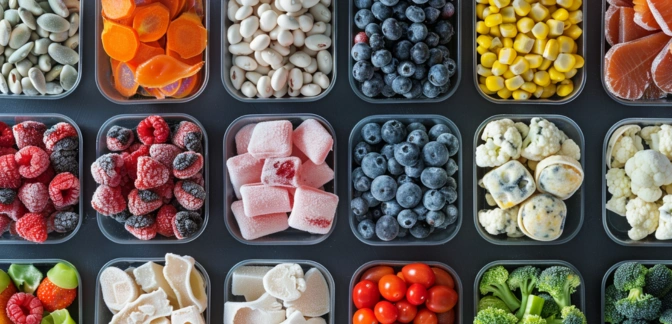Frozen Seafood — Nutrients, Health Benefits, And Shopping Tips

Written by Listonic Team
Last update on September 4, 2024
Nutrition facts
Nutrition facts
Amount per 100 g
Calories
🔥 77 kcal
| Nutrition per: 100 g | Value | % Daily Value* |
|---|---|---|
| Carbs | 0 g | - |
| Fiber | 0 g | - |
| Sugars | 0 g | - |
| Glycemic Index | 0 | - |
| Protein | 16 g | 32% |
| Sodium | 150 mg | 6.52% |
| Total Fat | 1 g | 1.28% |
*The % of Daily Value (DV) tells you how much a nutrient in a serving of food contributes to a daily diet. 2,000 calories a day is used for general nutrition advice.
16 g
🧀 Good Protein Content
Did you know?
Health benefits
- Rich in protein, essential for muscle growth, repair, and overall body function.
- High in omega-3 fatty acids (in fatty fish), which support heart health, reduce inflammation, and improve brain function.
- Contains essential vitamins and minerals such as Vitamin B12, iodine, and selenium, which support overall health and well-being.
Health risks
- Risk of contamination with harmful bacteria, viruses, or toxins, particularly if the seafood is not properly handled, stored, or cooked to a safe internal temperature.
- High sodium content in some frozen seafood products, particularly if they are pre-seasoned or processed, which can contribute to hypertension and increased cardiovascular risks.
- Potential for allergic reactions in individuals with seafood allergies, causing symptoms like itching, swelling, or anaphylaxis.
- Environmental concerns related to the sustainability of seafood harvesting or farming practices and their impact on marine ecosystems.
How to choose frozen seafood
Frozen seafood, whether it's fish, shellfish, or squid, should be solid and free of ice burn. Inspect the color and texture; it should be consistent and bright, indicative of good freezing practices.
Stay away from any seafood with discoloration or an ammonia scent. Properly frozen seafood should taste as good as fresh when cooked, maintaining its natural flavor and texture.

How to store frozen seafood
Frozen seafood should be kept in the freezer until needed. Store it in its original packaging or transfer to a freezer-safe container. Properly stored, frozen seafood can last up to six months.
Repeated thawing and refreezing can deteriorate the texture and flavor. Sealed packaging helps prevent air exposure and freezer burn. Maintaining consistent freezing conditions ensures the best quality and freshness.
✅ Extra Tip
How long does it last?
Frozen seafood can last for 3-6 months in the freezer when stored in an airtight container or freezer bag. For the best quality, consume it within this time frame.
What to do with leftovers?
Leftover frozen seafood can be used in a variety of dishes. Thaw and add it to a seafood stew or chowder, where it adds richness and flavor, or sauté with garlic, butter, and herbs for a quick and delicious main dish. Seafood is also great in pasta dishes, where it can be mixed with a creamy or tomato-based sauce.
Use frozen seafood in a seafood paella or risotto, where its flavors complement the other ingredients. If you have a lot of frozen seafood, consider making a batch of seafood skewers with vegetables, perfect for grilling or roasting. Seafood can also be added to a seafood salad with a tangy vinaigrette, or used as a topping for pizzas or flatbreads. For a quick appetizer, serve seafood with a dipping sauce like cocktail sauce or garlic butter, or mix it into a seafood casserole with cheese and breadcrumbs.
👨⚕️️ Medical disclaimer
Discover products from other categories
Listonic Team
Fact-checked
Our editorial team checked this article to make sure it was accurate at the time of publishing it.
Get the top-rated shopping list app

frozen seafood
1 piece







